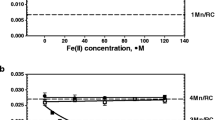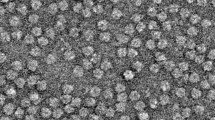Abstract
Four possible ways to prepare QA-depleted, Fe-depleted and QA-reconstituted RCs were studied: (1) first depleting the Fe, then depleting QA and finally reconstituting QA (D-Fe, D-Q, R-Q), (2) first depleting QA, then depleting the Fe and finally reconstituting QA (D-Q, D-Fe, R-Q), (3) first depleting QA, then reconstituting QA and finally depleting Fe (D-Q, R-Q, D-Fe), (4) first depleting QA, then depleting the Fe and reconstituting QA in the same step (D-Q, D-Fe-R-Q). Our results showed that: method (1) results in the irreversible loss of photochemical activity; method (2) and (3) result in low recovery of the photochemical activity and poor yield of Fe-depleted, QA-reconstituted RCs; method (4) gives surprisingly good results. This method allows for the first time to prepare the QA-depleted, Fe-depleted, QA-reconstituted RCs with high recovery of the photochemical activity and good yield. The sample has 98% of photochemical activity (yield of P+ QA -) compared with that of the native RCs and shows strong polarization of the EPR signal of QA - under continuous illumination at 5K. The decay halftime of I- is slow (∼5 ns) compared with that of the native RCs, but it is the same as that measured for the RCs from which only iron is removed. These results indicate that the depletion of iron and the reconstitution of QA have been successful. Reconstitution of the QA-depleted, Fe-depleted and QA-reconstituted RCs with Zn2+ gives also the spin-polarized QA -, and yields the same decay of I- (halftime 200 ps) as that of the native RCs.
Similar content being viewed by others
Abbreviations
- LDAO:
-
lauryldimethylamine N-oxide
- EDTA:
-
ethylenediaminetetraacetic acid
- BSA:
-
albumin bovine
- TL buffer:
-
10 mM Tris.HCl, 0.1% LDAO and 0.1 mM EDTA
References
Agalidis, I, Nuijs, AM and Reiss-Husson, F (1987) Characterization of an LM unit purified by affinity chromatography from Rhodobacter sphaeroides reaction centers and interaction with the H subunit. Biochim Biophys Acta 890: 242–250
Beales, KJ, Cooper, WD and Eleg, DD (1978) Protein quinone complexes. Bovine plasma albumin and hologenated p-quinones. J Bioenerg and Biomembr 10: 101–108
Blankenship, RE and Parson, WW (1979) The involvement of iron and ubiquinone in electron transfer reactions mediated by reaction centers from photosynthetic bacteria. Biochim Biophys Acta 545: 429–444
Debus, RJ, Feher, G and Okamura, MY (1986) Iron-depleted reaction centers from Rhodopseudomonas sphaeroides R-26. 1: characterization and reconstitution with Fe2+, Mn2+, Co2+, Ni2+, Cu2+ and Zn2+. Biochemistry 25: 2276–2287
Feher, G and Okamura, MY (1978) Chemical composition and properties of reaction centers. In: Clayton, RK and Sistrom, WR (eds) The Photosynthetic Bacteria, p 379. Plenum Press, New York and London
Gast, P, Mushlin, RA and Hoff, AJ (1982) Nonuniform transfer of electron spin polarization in reaction centers of the photosynthetic bacterium Rhodopseudomonas sphaeroides. J Phys Chem 86: 2886–2891
Gast, P, Michalski, TJ, Hunt, JE and Norris, JR (1985) Determination of the amount and the type of quinones present in single crystals from reaction centers from the photosynthetic bacterium Rhodopseudomonas viridis. FEBS Lett 179: 325–328
Gunner, MR, Robertson, DE and Dutton, PL (1986) Kinetics study on the reaction center protein from Rhodopseudomonas sphaeroides: the temperature and free energy dependence of electron transfer between various quinones in the QA site and the oxidized bacteriochlorophyll dimer J Phys Chem 90: 3783–3795
Kirmaier, C, Holten, D, Debus, RJ, Feher, G and Okamura, MY (1986) Primary photochemistry of iron-depleted and zinc-reconstituted reaction centers from Rhodopseudomonas sphaeroides. Proc Natl Acad Sci USA 83: 6407–6411
Kleinfeld, D, Okamura, MY and Feher, G (1985) Charge recombination kinetics as a probe of protonation of the primary acceptor in photosynthetic reaction centers. Biophys J 48: 849–852
Marinetti, TD, Okamura, MY and Feher, G (1979) Location of the primary quinone binding site in reaction centers from Rhodopseudomonas sphaeroides R-26 by photoaffinity labeling, Biochemistry 18: 3126–3495
McComb, JC, Stein, RR and Wraight, CA (1990) Investigation on the influence of headgroup substitution and isoprene side-chain length in the function of primary and secondary quinones of bacterial reaction centers. Biochim Biophys Acta 1015: 156–171
Okamura, MY, Isaacson, RA and Feher, G (1975) Primary acceptor in bacterial photosynthesis: obligatory role of ubiquinone in photoactive reaction centers of Rhodopseudomonas sphaeroides. Proc Natl Acad Sci USA 72: 3491–3495
Sebban, P (1988a) pH effect on the biphasicity of the P+ Q- charge recomination kinetics in reaction centers from Rhodobacter sphaeroides, reconstituted with anthra-quinones. Biochim Biophys Acta 936: 124–132
Sebban, P (1988b) Activation energy of the rate constant of P+ QA - absorption decay in reaction centers from Rhodobacter sphaeroides, reconstituted with different anthra-quinones. FEBS Lett 233: 331–334
Smit, HWJ, Amesz, J and Van derHoeven, MFR (1987) Electron transport and triplet formation in membranes of the photosynthetic bacterium Heliobacterium chlorum. Biochim Biophys Acta 893: 232–240
Tiede, DM and Dutton, PL (1981) Orientation of the primary quinone of baterial photosynthetic reaction centers contained in chromatophore and reconstituted membranes. Biochim Biophys Acta 637: 278–290
Warncke K, Gunner MR, Braun BS, Yu CA and Dutton PL (1987) Effect of hydrocarbon tail structure on the affinity of substituted quinone for the QA and QB sites in reaction center protein of Rhodopseudomonas sphaeroides R-26. Biophys J 51: 124a
Woodbury, NW, Parson, WW, Gunner, MR, Prince, RC and Dutton, PL (1986) Radical-pair energetics and decay mechanisms in reaction centers containing anthraqionones, naphthoquinones or benzoquinones in place of ubiquinone. Biochim Biophys Acta 851: 6–22
Wraight, CA (1981) Oxidation-reduction physical chemistry of the acceptor quinone complex in bacterial photosynthetic reaction centers: evidence for a new model of herbicide activity. Isr J Chem 21: 348–354
Author information
Authors and Affiliations
Rights and permissions
About this article
Cite this article
Liu, BL., Yang, LH. & Hoff, A.J. On the depletion and reconstitution of both QA and metal in reaction centers of the photosynthetic bacterium Rb. sphaeroides R-26. Photosynth Res 28, 51–58 (1991). https://doi.org/10.1007/BF00033714
Received:
Accepted:
Issue Date:
DOI: https://doi.org/10.1007/BF00033714




